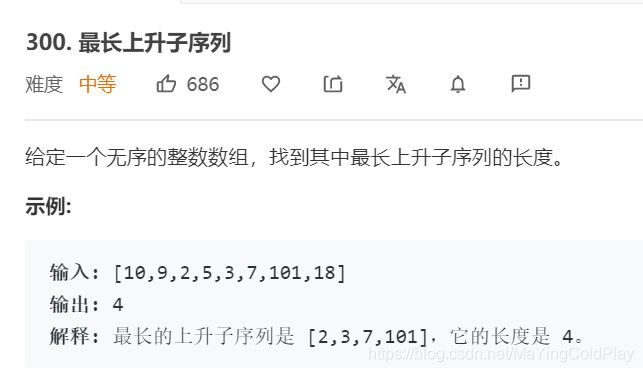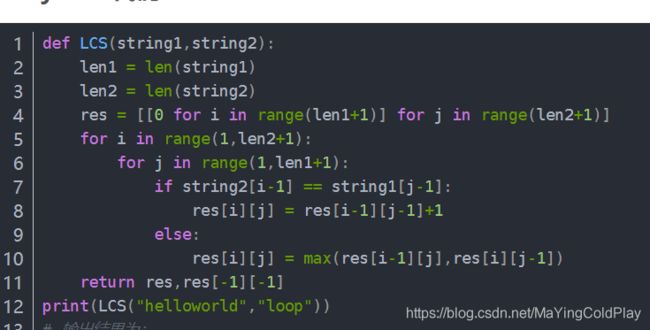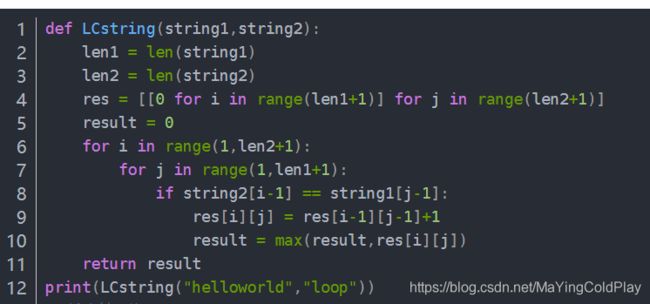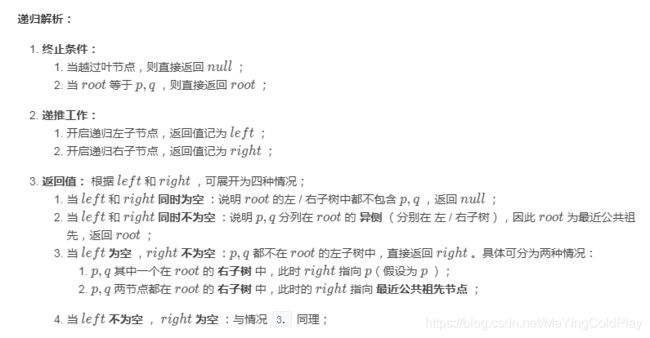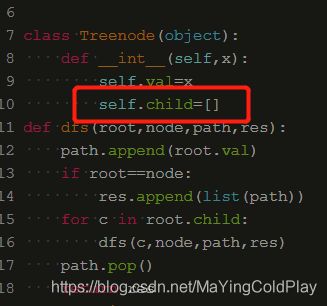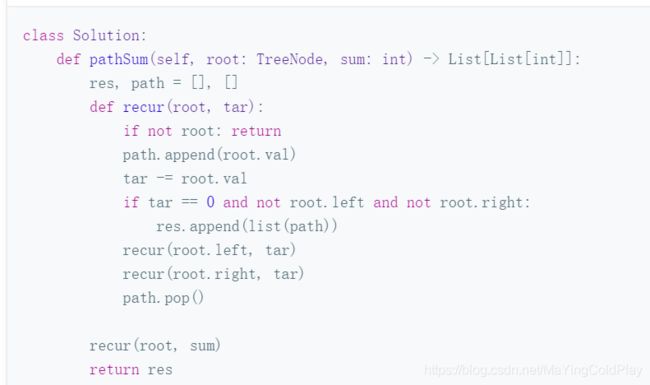剑指offer-leetcode-最大最小问题-思路篇
接
https://blog.csdn.net/MaYingColdPlay/article/details/105905939
字符串问题用动态规划
二叉树路径问题用回溯法
1.无重复字符最长子串
双指针法,用一个left指针,指向最左边,一个cur指针,指向当前,记录两者之间的距离。
用一个列表来记录当前无重复字符。如果有重复的子串,移动left指针。
不用两个指针也可,直接用一个list来判断就行了。list+从左边pop出当前存在的。
2.最小路径和
思路:
拿例子来说,dp[2][2]=min(dp[2][1],dp[1][2])+grid[2][2],其中等式右边的dp也都是这么求的。
dp[1][2]=min(dp[1][1],dp[0][2])+grid[1][2] ...动态规划数学方程。
首先对dp赋初始值,初始值就是i=0和j=0的时候。
3.最长回文子串
思路:用一个dp来表示从i到j是否为回文子串,首先初始化,dp[i][i]是True。
然后从index为1开始进行遍历,如果s[i]==s[j],分两种情况,如果是两个挨着的,是True,
如果不是挨着的,等于他上一个状态。
判断是否为最大值,如果是最大值,记录当前的下标i和max_len,从s中进行索引。
4.最长上升子序列
思路:动态规划,dp[i]表示到位置i时的最长上升子序列,从0遍历到i,如果nums[i]大于nums[j],
dp[i]=dp[j]+1,注意要选择dp[i]与dp[j]+1的最大值。
5.最大子序和
dp[i]表示到i为止的连续子数组最大值。dp[i]=等于max(dp[i-1]+nums[i],num[i])
6.最长公共子序列
https://blog.csdn.net/ggdhs/article/details/90713154
在写代码的时候,为了赋初值方便,dp矩阵多增加一维,从字符串前面一位开始算。
7.最长公共子串
8.二叉搜索树的最近公共祖先
https://leetcode-cn.com/problems/er-cha-sou-suo-shu-de-zui-jin-gong-gong-zu-xian-lcof/solution/mian-shi-ti-68-i-er-cha-sou-suo-shu-de-zui-jin-g-7/
9.二叉树的最近公共祖先
9.1递归
https://leetcode-cn.com/problems/er-cha-shu-de-zui-jin-gong-gong-zu-xian-lcof/solution/mian-shi-ti-68-ii-er-cha-shu-de-zui-jin-gong-gon-7/
# Definition for a binary tree node.
# class TreeNode(object):
# def __init__(self, x):
# self.val = x
# self.left = None
# self.right = None
class Solution(object):
#回溯,传入参数是root,path,如果root.val等于节点值,就把路径加入结果中。
def dfs(self,root,path,res,target):
path.append(root)
if root.val==target:
res.append(list(path))
if root.left:
self.dfs(root.left,path,res,target)
if root.right:
self.dfs(root.right,path,res,target)
path.pop()
return res
def lowestCommonAncestor(self, root, p, q):
"""
:type root: TreeNode
:type p: TreeNode
:type q: TreeNode
:rtype: TreeNode
"""
#找到两个节点的路径,然后取第一个交点。
path1=[]
path2=[]
res1=[]
res2=[]
res1=self.dfs(root,path1,res1,p.val)[0]
res2=self.dfs(root,path2,res2,q.val)[0]
index1=0
index2=0
while index1<=len(res1)-2 and index2<=len(res2)-2:
if res1[index1+1]!=res2[index2+1]:
return res1[index1]
else:
index1=index1+1
index2=index2+1
if index1==len(res1)-1 and index29.2 非递归
https://leetcode-cn.com/problems/lowest-common-ancestor-of-a-binary-tree/solution/xiong-mao-shua-ti-python3-hui-su-2tiao-lu-jing-sha/
回溯
扩展:多叉树的情况
在类里面用一个list来保存多个子节点。
面试题34. 二叉树中和为某一值的路径
https://leetcode-cn.com/problems/er-cha-shu-zhong-he-wei-mou-yi-zhi-de-lu-jing-lcof/solution/mian-shi-ti-34-er-cha-shu-zhong-he-wei-mou-yi-zh-5/
# class TreeNode(object):
# def __init__(self, x):
# self.val = x
# self.left = None
# self.right = None
class Solution(object):
#回溯,传入参数为root,res,target(根节点,保存结果的list,sum减去root.val)
def __init__(self):
self.res=[]
def dfs(self,root,target,path):
if not root:
return
path.append(root.val)
if target==root.val and not root.left and not root.right:
self.res.append(list(path))
if root.left:
self.dfs(root.left,target-root.val,path)
if root.right:
self.dfs(root.right,target-root.val,path)
path.pop()
def pathSum(self, root, sum):
"""
:type root: TreeNode
:type sum: int
:rtype: List[List[int]]
"""
path=[]
self.dfs(root,sum,path)
return self.resif __name__=="__main__":
#构造二叉树
n1=TreeNode(5)
n21=TreeNode(4)
n22=TreeNode(8)
n31=TreeNode(11)
n32=TreeNode(13)
n33=TreeNode(4)
n41=TreeNode(7)
n42=TreeNode(2)
n43=TreeNode(5)
n44=TreeNode(1)
n1.left=n21
n1.right=n22
n21.left=n31
n22.left=n32
n22.right=n33
n31.left=n41
n31.right=n42
n33.left=n43
n33.right=n44
result=Solution().pathSum(n1,22)
print(result)






